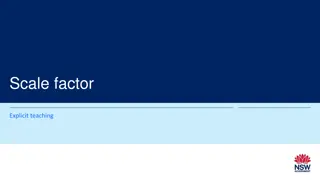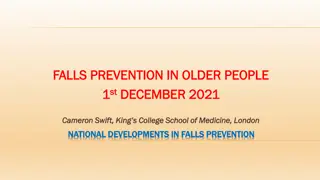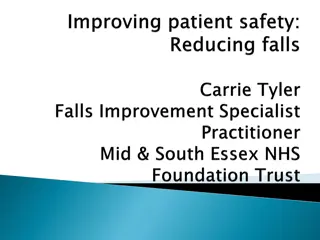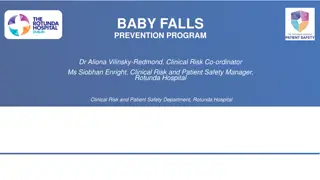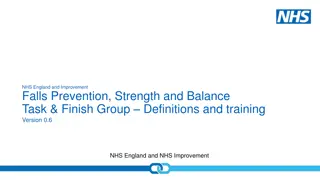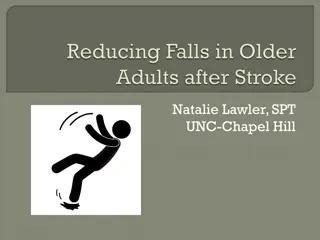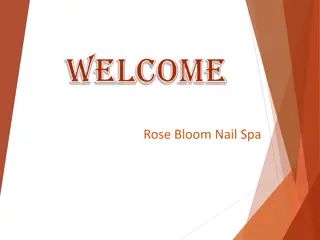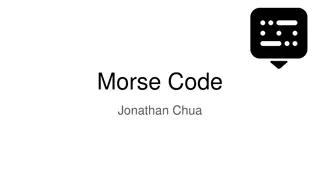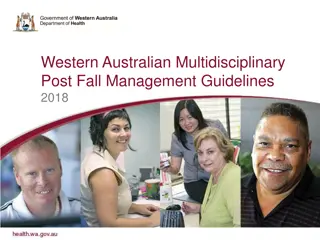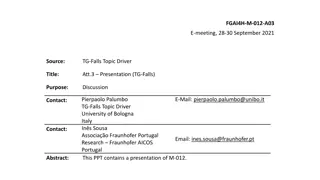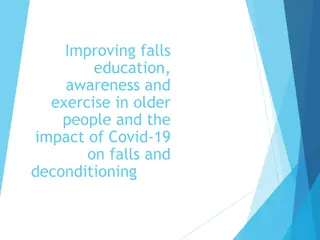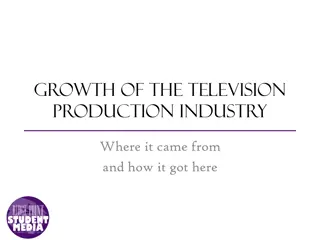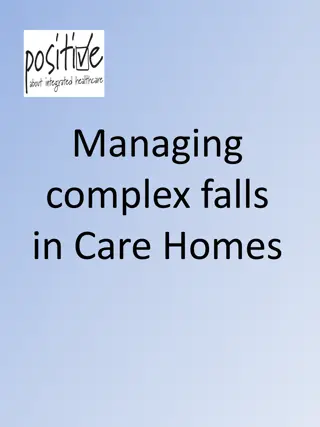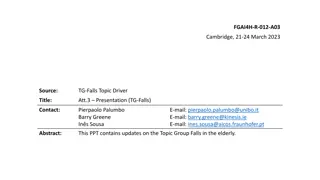Comprehensive Overview of Morse Fall Scale and Its Application in Preventing Falls
Falls among hospitalized patients pose a significant risk, with 30-50% resulting in injuries. The Morse Fall Scale (MFS) is a widely used method to assess fall risk, comprising six variables with predictive validity. Factors such as history of falling, ambulatory aids, gait, and mental status are crucial in determining a patient's likelihood of falling. Understanding and implementing the MFS can aid healthcare providers in preventing falls and improving patient safety.
Download Presentation

Please find below an Image/Link to download the presentation.
The content on the website is provided AS IS for your information and personal use only. It may not be sold, licensed, or shared on other websites without obtaining consent from the author.If you encounter any issues during the download, it is possible that the publisher has removed the file from their server.
You are allowed to download the files provided on this website for personal or commercial use, subject to the condition that they are used lawfully. All files are the property of their respective owners.
The content on the website is provided AS IS for your information and personal use only. It may not be sold, licensed, or shared on other websites without obtaining consent from the author.
E N D
Presentation Transcript
Falls YEARLY COMPETENCY
Falls Falls result in a significant number of injuries among hospitalized patients, long-term care residents, and the home care population. Thirty to fifty percent of the falls in the acute care setting result in injury
Morse Fall Scale The Morse Fall Scale (MFS) is a rapid and simple method of assessing a patient s likelihood of falling. It consists of six variables that are quick and easy to score, and it has been shown to have predictive validity and interpreter reliability. The MFS is used widely in acute care settings, both in the hospital and long term care inpatient settings.
Morse Breakdown History of falling Secondary Diagnosis This is scored as 25 if the patient has fallen during the present hospital admission or if there was an immediate history of physiological falls, such as from seizures or an impaired gait prior to admission. If the patient has not fallen, this is scored 0. Note: If a patient falls for the first time, then his or her score immediately increases by 25. This is scored as 15 if more than one medical diagnosis is listed on the patient s chart; if not, score 0.
Morse Breakdown Ambulatory Aids Intravenous Therapy This is scored as 0 if the patient walks without a walking aid (even if assisted by a nurse), uses a wheelchair, or is on a bed rest and does not get out of bed at all. This is scored as 20 if the patient has an intravenous apparatus or a heparin lock inserted; if not, score 0. If the patient uses crutches, a cane, or a walker, this item scores 15 if the patient ambulates clutching onto the furniture for support, score this item 30.
Morse Breakdown Gait Mental Status When using this Scale, mental status is measured by checking the patient s own self assessment of his or her own ability to ambulate. the patient is rated as normal and scored 0. A normal gait is characterized by the patient walking with head erect, arms swinging freely at the side, and striding without hesitant. This gait scores 0. With a weak gait (score as 10), the patient is stooped but is able to lift the head while walking without losing balance. Steps are short and the patient may shuffle. If the patient s response is not consistent with the nursing orders or if the patient s response is unrealistic, then the patient is considered to overestimate his or her own abilities and to be forgetful of limitations and scored as 15. With an impaired gait (score 20), the patient may have difficulty rising from the chair. The patient s head is down, and he or she watches the ground. Because the patient s balance is poor, the patient grasps onto the furniture, a support person, or a walking aid for support and cannot walk without this assistance.
Morse Fall Scale Scores Morse Fall Score High Risk Red Sign 45 and higher Moderate Risk Yellow Sign 25 44 Low Risk No Sign 0 24
Recommended interventions based on fall scores Precautions Low Risk Moderate Risk High Risk Bed in Low position Night Light in Use Bed/Chair brakes locked Call light within reach Hourly Rounding Non-slip footwear (Yellow Socks) Medication side effects awareness Patient/family education about fall risk Side rails up (X2) Fall risk band on patient Fall Risk Signage in place (Yellow for Mod Risk, Red For High Risk) Yellow Gown Bed Zone 2 Remind that staff assist with mobility Bed exit alarm on Bedside commode Review/initiate fall risk care plan Monitor orthostatic BP Relocate Patient bed (If Appropriate) X X X X X X X X X X X X X X X X X X X X X X X X X X X X X X X X X X X X
Fall Prevention Audits Unit directors and charge nurse will be preforming chart/intervention audits on high risk patients to ensure the proper interventions are in place to prevent patient falls.
Post Fall Huddle Form In the event of a fall we are now asking Unit staff to hold a brief post fall huddle. The primary nurse or charge nurse will fill out the form and turn in a copy to the director and place the original in the yellow fall binder located on each unit (this does NOT replace an ORTS report). Please make sure to fill out the form in its entirety.
STEADY S: SIGNAGE on door and only STAFF can transfer the patient in or out of bed and STAY with patient in or outside the bathroom at all times. T: TOILETING will be assessed during hourly rounding and Gait Belt will be used to TRANFER patient E: EDUCATE everyone including Family members of S and the use of Call light A: ACTIVATE bed exit alarm and zone per patient need. D: DISCUSS fall risk score at bedside shift report and the need for a bedside commode Y: Yellow Socks and Fall Risk Band
Prevent the Next Fall Tips Interventions Risk Levels Universal/Low Risk: For all patients with Morse Score of 0 to 24. Implement the Universal Fall Precaution Interventions Document the activation of STEADY in Cerner. That is your proof of safety measures implemented for fall prevention. If it is not documented it is not done. Evaluate room placement closer to the nurses station Ask the family to stay and notify you when leaving Communicate Fall Risk and Interventions with Team Members Moderate Risk: For all patients with Morse Score of 25 to 44. Implement the Moderate fall risk Interventions The Fall Bundle is ALL or Nothing- you cannot pick and choose components to implement. Initiate the bundle and follow through with it. Educate Educate Educate Don t forget the Basics: If the patient has a high fall score and/or they have fallen previously during the hospital stay, staff should consider obtaining approval from the respective ACNO for use of a sitter. (Sitter need should be determined every shift for appropriateness) High Risk: For all patients with Morse Score of 45 and higher. Implement High Risk Fall Intervention STEADY Keep bed in its lowest position Keep call light and belongings within reach Keep the Bedside commode reachable Keep a clear path to the bathroom The patient s fall risk should be assessed upon admission, each shift, after change in unit or after any change in health status. Review fall risk care plan
http://www.networkofcare.org/library/Morse%20Fall%20Scale.pdf


